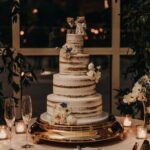When is the wedding cake cut? The cutting of the wedding cake is a cherished tradition that holds significant symbolism in many cultures. As a focal point of the reception, the wedding cake represents unity and the couple’s first task together as a married couple. This article explores the history, symbolism, and customs surrounding this time-honored tradition.
The tradition of cutting the wedding cake dates back centuries and has evolved over time. From a simple breaking of bread to elaborate multi-tiered confections, the act of cutting the cake has become an integral part of wedding celebrations around the world. Understanding the origins and evolution of this tradition provides insight into its enduring significance.
The symbolic meaning behind cutting the wedding cake goes beyond just sharing dessert with loved ones. The act is often seen as a symbol of the couple’s commitment to providing for each other and their guests, as well as their future together. This ceremonial moment also signifies their first joint task as they embark on their journey as spouses. Throughout various cultures and religious ceremonies, this ritual holds deep meaning and importance in uniting the newlyweds and their families.
The History of Cutting the Wedding Cake
The tradition of cutting a wedding cake dates back to ancient Rome, where it symbolized the couple’s first joint task. The groom would break a loaf of barley bread over the bride’s head, ensuring fertility and prosperity. However, the modern concept of a tiered wedding cake didn’t emerge until the 19th century in England, when multiple cakes were stacked on top of each other and eventually replaced with one large cake.
Over time, the act of cutting the wedding cake has evolved into a significant ritual during the wedding reception. The sweet treat has become an essential element of the celebration, symbolizing good luck and prosperity for the newlyweds as they embark on their journey together. Additionally, the cake cutting ceremony signifies the couple’s commitment to care for each other and mutually provide sustenance.
Furthermore, as cakes became more elaborate and decorative, so did the significance of cutting them. It is now a focal point at most wedding receptions and often captured as a memorable moment by photographers and videographers alike. Couples can choose to incorporate personal touches into this custom or even opt for non-traditional alternatives such as cupcake towers or dessert bars to reflect their unique personalities and tastes.
- Origins of Cutting the Wedding Cake
- Ancient Roman tradition
- Emergence of tiered wedding cakes in 19th century England
- Evolution of Cake Cutting Ritual
- Modern significance in wedding celebrations
- Symbolism of luck and prosperity
- Personalized Cake Cutting Options
- Non-traditional alternatives such as cupcakes or dessert bars
- Incorporating personal touches into this time-honored tradition
The Symbolism Behind the Cake Cutting
The cutting of the wedding cake is a significant and time-honored tradition that holds a symbolic meaning in the wedding ceremony. The act of cutting the cake together symbolizes the first task that the couple performs as newlyweds, signifying their commitment to provide for each other. As they feed each other with the first slice of cake, it symbolizes their promise to always support and nourish one another throughout their married life.
Additionally, the cake cutting ritual represents the shared responsibilities and unity within the marriage. By working together to cut and serve the cake, couples show their dedication to collaborating and working as a team in facing life’s challenges. It also serves as a public display of affection and unity, allowing guests to witness and celebrate the couple’s union before partaking in sweet treats.
Traditionally, the cake cutting takes place after dinner and before dancing at the wedding reception. It signifies a transition from formal dining to more casual celebrations, marking a pivotal moment in the event. The timing of when is the wedding cake cut may vary depending on cultural or personal preferences, but it generally occurs towards the latter part of the reception program.
| Symbolism Behind Cake Cutting | Significance |
|---|---|
| First task as newlyweds | Commitment and provision for each other |
| Unity and shared responsibilities | Dedication to collaboration within marriage |
| Transition from formal dining to casual celebration |
When Is the Wedding Cake Cut
The cutting of the wedding cake is a significant tradition in many cultures and is often a highly anticipated moment during the wedding reception. This symbolic act symbolizes the first activity that the newlyweds do together as a married couple. The cake-cutting ritual also serves as an opportunity for the couple to share their first sweet bite as spouses, and it is a joyful occasion that is cherished by both the couple and their guests.
Traditionally, the wedding cake cutting takes place after the main course has been served, signaling the transition from dinner to dessert. It often follows the first dance or other special activities such as speeches and toasts. However, in modern weddings, some couples choose to cut their cake earlier in the reception, before or after their grand entrance as newlyweds.
One common reason for cutting the cake earlier in the evening is to allow time for photographs and entertainment during this special moment before guests start leaving. Regardless of when it occurs, couples typically consult with their wedding planner, venue coordinator, or DJ to coordinate when they want this event to take place during their reception.
| Point | Data |
|---|---|
| Traditional timeline | After main course and special activities |
| Modern trend | Earlier in the evening |
| Consultation | With wedding planner or venue coordinator |
Who Is Involved in the Cake Cutting
The wedding cake cutting ceremony is a cherished tradition that holds special significance in many cultures around the world. This symbolic act marks the first task that the newlyweds perform together and is often seen as a symbol of their future unity and partnership. While the bride and groom are, of course, the focal participants in this ceremonial event, there are also other key individuals who traditionally play a role in the cake cutting.
1. The Bride and Groom: Naturally, the bride and groom are at the center of the cake cutting ceremony. They often stand side by side as they slice into their beautifully adorned confectionery creation. This act not only symbolizes their union but also represents their first collaborative effort as a married couple.
2. Wedding Officiant or Emcee: In many weddings, it is customary for the officiant or emcee to provide some context or narration during the cake-cutting ceremony. They may share well wishes for the couple or offer a brief explanation of the symbolism behind this tradition.
3. Parents or Close Family Members: It is common for parents or close family members to have an important role when it comes to wedding traditions, including the cake cutting. They may offer support and guidance to ensure that the couple’s experience is seamless and memorable on their special day.
The roles outlined here encompass traditional practices but can certainly be adapted to reflect a couple’s unique preferences and circumstances on their wedding day. Ultimately, it’s essential for all participants in this ceremony to honor and celebrate a new chapter in the lives of those getting married.
The Cake Cutting Ceremony
Setting the Stage
Before the cake cutting takes place, it’s important for couples to consider the logistical details. The location of the cake should be easily accessible, and there should be ample space for guests to gather around and witness the event. Additionally, couples may choose to enhance the ambiance by selecting a meaningful song to play during the cake cutting.
The Act of Cutting
When is the wedding cake cut? Typically, the cake cutting takes place after the main meal has been served, but before dessert is enjoyed by guests. The couple stands side by side, with the bride typically placing her right hand on top of the groom’s as they together make that first slice into their wedding confection. This act symbolizes their unity and commitment to sharing in life’s joys and challenges.
Feeding Each Other
After that initial cut, it is customary for each partner to feed a small piece of cake to one another as a display of love and care. This lighthearted gesture symbolizes their commitment to providing for each other throughout their marriage. Couples should playfully – yet carefully – feed each other without making a mess or causing any embarrassment.
Wedding Cake Cutting Alternatives
As weddings become more personalized and unique, many couples are choosing to forego the traditional cake cutting ceremony in favor of non-traditional alternatives. These creative and innovative ideas add a touch of individuality to the wedding celebration and can make the cake cutting moment even more memorable.
One popular alternative to the traditional cake cutting is the use of cupcakes or mini desserts. Instead of a tiered wedding cake, couples are opting for displays of assorted sweet treats that guests can easily grab and enjoy. This not only adds variety to the dessert selection but also eliminates the need for a formal cake cutting ceremony.
Another non-traditional approach to the cake cutting is the use of themed or novelty cakes. Rather than the classic white tiered cake, some couples are choosing themed cakes that reflect their personalities or interests. From superhero or movie-themed cakes to elaborate sculpted designs, these non-traditional creations add an element of fun and whimsy to the wedding reception.
For those looking to completely break away from tradition, some couples are choosing to forgo a wedding cake altogether. Instead, they opt for alternative dessert options such as donut walls, ice cream bars, or even savory snack stations. This departure from the classic cake cutting ceremony allows couples to showcase their unique tastes and preferences while providing guests with an unexpected culinary experience at the reception.
Ultimately, when it comes to choosing how to cut their wedding cake, couples have countless non-traditional options that allow them to personalize this cherished moment in a way that reflects their individual style and vision for their special day.
Tips for a Memorable Cake Cutting Moment
Choose the Right Cake
When it comes to creating a memorable cake cutting moment, the type of cake you choose can make a significant impact. Consider selecting a cake flavor and design that reflects your personalities as a couple. Whether it’s a classic tiered cake, a modern naked cake, or a whimsical themed cake, the choice of cake can add an extra layer of meaning to the cake cutting ceremony.
Customize the Cutting Utensils
To add a personal touch to the cake cutting experience, consider using customized utensils for the ceremony. Engraved cake servers or personalized cake knives can become cherished keepsakes from your wedding day. They also serve as a symbol of unity and can be passed down through generations as a meaningful heirloom.
Embrace Creativity and Personalization
Don’t be afraid to think outside the box when it comes to the cake cutting moment. Some couples choose to incorporate unique elements such as fireworks, confetti cannons, or even special effects lighting to create an unforgettable spectacle during the cake cutting. Embracing creativity and personalization can elevate this tradition into an extraordinary and memorable experience for both you and your guests.
Conclusion
In conclusion, the cutting of the wedding cake holds a significant role in the overall celebration of a couple’s marriage. From its historical origins to the symbolic meaning behind it, the act of cutting the wedding cake is a time-honored tradition that marks the beginning of a couple’s life together.
Whether it be a traditional or non-traditional approach, the cake cutting ceremony is an integral part of the wedding reception and is often accompanied by meaningful rituals and etiquette.
The timing of when the wedding cake is cut can vary, but it typically takes place after the meal and before dancing begins. This provides a perfect segue from dinner to dessert and signifies that the formalities of the evening are coming to an end. The couple usually cuts the first slice together, symbolizing their unity and shared future. This touching moment is often captured by photographers and videographers, preserving it as a cherished memory for years to come.
Ultimately, how couples choose to approach their wedding cake cutting is entirely up to them. Some may opt for a traditional tiered cake with intricate designs, while others may choose unique alternatives such as cupcakes, donuts, or even pie. Regardless of the style or method chosen, the significance remains clear – the act of cutting into their wedding cake represents love, commitment, and unity as they embark on this new chapter together.
Frequently Asked Questions
Is the Cake Cut Before or After Dancing?
Traditionally, the cake cutting occurs after the first dance at a wedding reception. It serves as a sweet transition from the formalities of the meal to the start of the party and dancing.
What Comes First Toast or Cake Cutting?
The toast typically comes before the cake cutting at a wedding reception. This allows for heartfelt and celebratory speeches to precede the sweet dessert moment, setting an emotional tone for the evening.
What Is the Tradition of Cutting the Wedding Cake?
The tradition of cutting the wedding cake symbolizes the couple’s first joint task as spouses. By feeding each other a small piece of cake, they demonstrate their commitment to provide for one another and share in their new life together.

I have been involved in marriages for over 20 years helping couples and singles understand more about them.





